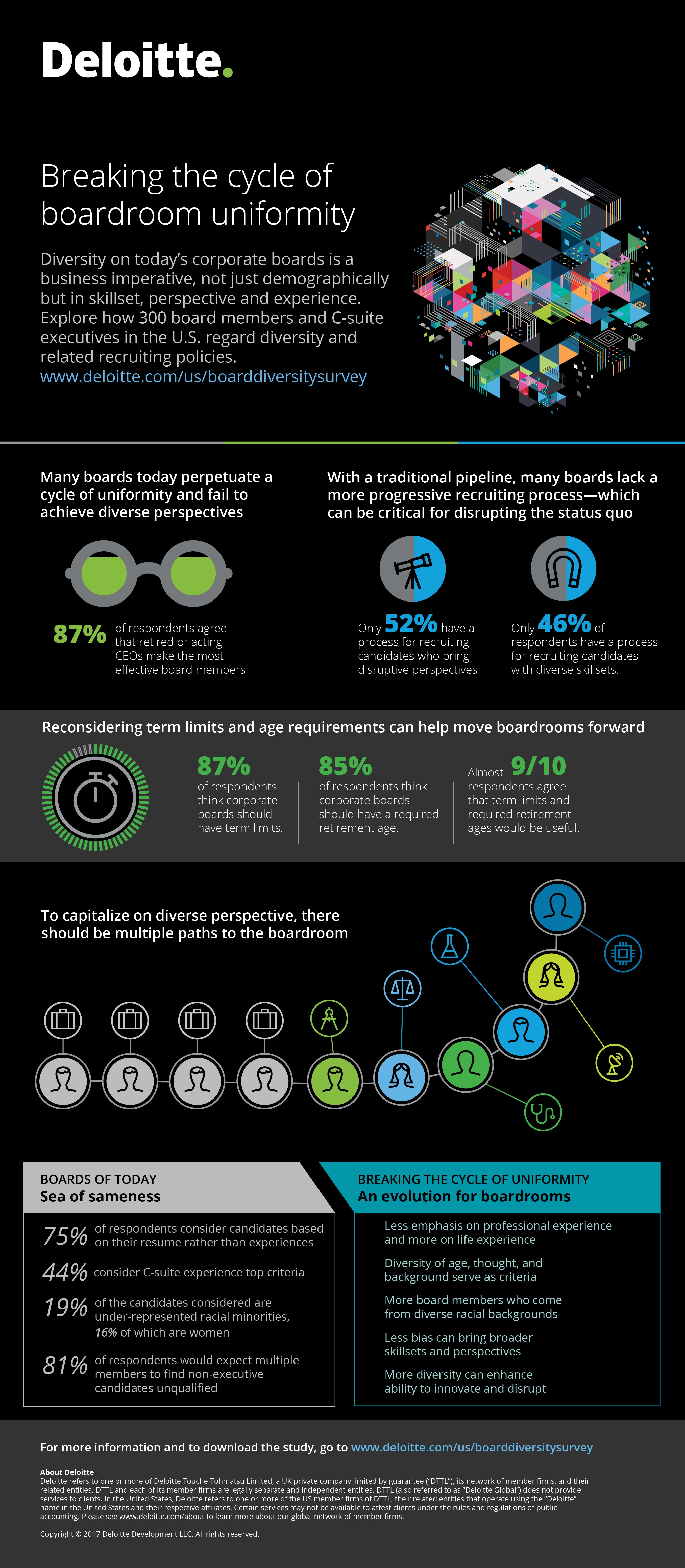2017 board diversity survey: Seeing is believing has been saved

Analysis
2017 board diversity survey: Seeing is believing
The benefits of diversity in the boardroom
The evidence is in. Business leaders clearly believe in the benefits of diversity on their boards of directors. Yet it’s equally clear that current methods of sourcing and selecting candidates tend to reinforce a lack of diversity.
Explore content
- Download the survey
- Perceptions of board diversity
- Board recruitment and evaluation practices
- The "Mixtocracy" model
- Related media coverage
About the survey
Three hundred board members and executives believe achieving greater diversity on corporate boards is a business imperative.
This report, commissioned by Deloitte US Chairman Mike Fucci examines the current state of today’s corporate boards and the need for boardrooms to become more diverse, not just demographically but in skillset, perspectives, and experiences. Those surveyed expressed near universal agreement that greater diversity provides a competitive advantage and improves business performance, yet many organizations are failing to capitalize.
Achieving diversity in the boardroom starts with updating the recruitment and succession planning process, a weak spot identified through the survey as many boards prioritize traditional requirements for membership like C-suite experience and specialized business skills over their desire for greater diversity. The survey offers potential solutions boards can implement to be more inclusive—among them, the notion of creating a mixtocracy—which is ensuring that those in the boardroom can offer different viewpoints, skills, backgrounds, and experiences to set organizations up for success.
Perceptions of board diversity
Boards agree on the need for diversity with ninety-five percent of respondents agreeing that their boards need to seek more candidates with diverse skills and perspectives. Note, however, that this finding does not reveal where diversity of skill sets and perspectives are needed. Thus, the skills and perspectives could be those of, say, financial or operating or information technology executives. Such backgrounds would represent diversity of skills and perspectives, but not the demographic diversity that the term “diversity” usually implies.
Board members see diversity as going beyond basic demographics as nine in ten respondents agree that gender and racial diversity alone does not produce the diversity required for an organization to be innovative or disruptive. This may be surprising, given that gender and racial differences are generally seen as contributing to diverse perspectives. Yet those contributions may be tempered if recruiting and selection methods skew toward candidates with the backgrounds and experiences of white males with executive experience.
More to the point, it would be unfortunate if a focus on diversity of skills and perspectives were to undermine or cloud the focus on gender and racial diversity. In fact, typical definitions of board diversity include a demographic component. Deloitte’s 2016 Board Practices Report found that 53 percent of large-cap and 45 percent of mid-cap organizations disclose gender data on their board’s diversity; the respective numbers for racial diversity are, far lower, however: 18 percent and 9 percent.
So, the deeper questions may be these:
- How does the board go about defining diversity?
- Does its definition include gender and racial factors?
- Does it also include factors such as skills, experiences, and perspectives?
- Will the board’s practices enable it to achieve diversity along these various lines?
Board recruitment and evaluation practices
Board recruitment practices have arguably not kept pace with the desire and need for greater corporate board diversity.
- Boards still rely on traditional candidate criteria: More than 90 percent of respondents would see a candidate without executive experience as unqualified. Almost 90 percent of board members see current or retired CEOs as the most effective board members. In addition, 81 percent of respondents would expect multiple board members to see a candidate without executive experience as unqualified to serve on the board.
- Boards also source a majority of their candidates from other boards—within their own industries: The low percentage of women candidates (16 percent) is striking, as is that of racial minorities (19 percent). However, that may be a logical outcome of a process favoring selecting candidates with board experience—who historically have tended to be white and male. So, in the recruitment process, board members are often seeking people who tend to be like themselves—and like management. Such a process may help to reinforce a lack of diversity in perspectives and experiences, as well as (in most companies) in gender and race.
- Boards rely heavily on resumes in recruitment and selection: Relying on resumes, which reflect organizational and educational experience, helps to reinforce traditional patterns of board composition.
- About half of organizations have processes focused on diverse skills and disruptive views: Given all their other responsibilities, many boards understandably rely on existing recruitment tools and processes. They use resumes, their networks, and executive recruiters—all of which tend to generate results very similar to past results. However, our current disruptive environment likely calls for more creative approaches to reaching diverse candidates.
- Policies affect board refreshment: Policies, as well as processes, can affect board composition. Low turnover on boards can not only hinder movement toward greater diversity but also lead to myopic views of operations or impaired ability to oversee evolving strategies and risks. Almost nine in ten leaders agree that term limits and required retirement ages would be useful.
- Current practices tend to limit diversity: Relying on current directors’ recommendations will generally produce candidates much like those directors. Recruiting firms can be valuable, but tend to adopt the client’s view of diversity. Tools such as board competency matrices generally do not account for an organization’s strategy, nor do they provide a very nuanced view of individual board members’ experiences and capabilities. In other words, bringing people with diverse skills, perspectives, and experiences to the board—as well as women and racial and ethnic minorities—requires more robust processes than those currently used by most boards.
Reconsidering term limits and age requirements can help move boardrooms forward:
- 87% of respondents think corporate boards should have term limits.
- 85% of respondents think corporate boards should have a required retirement age.
- Almost 9/10 respondents agree that term limits and required ages would be useful.
A path forward—The Mixtocracy Model
The term meritocracy describes organizational advancement based upon merit—talents and accomplishments—and aims to combat the nepotism and cronyism that traditionally permeated many businesses. However, too often meritocracy results in mirrortocracy in which all directors bring similar perspectives and approaches to governance, risk management, and other board responsibilities.
A board differs from a position, such as chief executive officer or chief financial officer, in that it is a collection of individuals. A board is a team and, like any other team, it requires people who can fulfill specific roles, contribute different skills and views, and work together to achieve certain goals.
Thus, a board can include nontraditional members who will be balanced out by more traditional ones. Many existing recruiting methods do too little to achieve true diversity. The prevalence of those criteria and methods can repeatedly send boards back to the same talent pool, even in the case of women and minority candidates. For example, Deloitte’s 2016 Board Diversity Census shows that female and black directors are far more likely than white male directors to hold multiple Fortune 500 board seats.
Therefore, organizations should consider institutionalizing a succession planning and recruitment process that more closely aligns to their ideal board composition and diversity goals. Here are three ways to potentially do that:
- Look beyond “the tried and true.” Even when boards account for gender and race, current practices may tend to source candidates with similar views. Succession plans should create seats for those who are truly different, for example someone with no board experience but a strong cybersecurity background or someone who more closely mirrors the customer base.
- Take a truly analytical approach. Developing the optimal mix on the board calls for considering risks, opportunities, and markets, as well as customers, employees, and other stakeholders. A data-driven analytics tool that assesses management’s strategies, the board’s needs, and desired director attributes can help define the optimal mix in light of those factors.
- Use more sophisticated criteria. Look beyond resumes and check-the-box approaches to recruiting women, minorities, and those with the right title. Surface-level diversity will not necessarily generate varying perspectives and innovative responses to disruption. Deep inquiry into a candidate’s outlook, experience, and fit can take the board beyond standard criteria, while prompting the board to more fully consider women and minority candidates—that is, to not see them mainly as women and minority candidates.
To learn more about how to construct and maintain a board that can meet evolving governance, advisory, and risk oversight needs, download the complete 2017 board diversity survey and download our breaking the cycle of boardroom uniformity infographic.
The Deloitte Chairman’s Survey was conducted in spring 2017 among 300 board members and C-suite executives at US companies with at least $50 million in annual revenue and at least 1,000 employees. Conducted by Wakefield Research via an email invitation and online questionnaire, the survey sought to ascertain respondents’ perspectives on board diversity and their organizations’ criteria and practices for recruiting and selecting board members. The margin of error for this study is +/- 5.7 percentage points at the 95 percent confidence level.
Related media coverage featuring Mike Fucci
- Addressing the leadership gap: Lessons higher education can learn from business
- Addressing the leadership gap with effective succession planning
- Sponsorship: A purpose-driven approach
- Sponsorship: A powerful career accelerator for diverse talent
- Sponsorship: Evolution in leadership calls for innovation in thinking
- Myth #5: Leadership comes with age
- Timeless leadership qualities to teach future CEOs
- Board succession: Getting it right

Recommendations
Women on boards
A matter of supply? Or demand?



